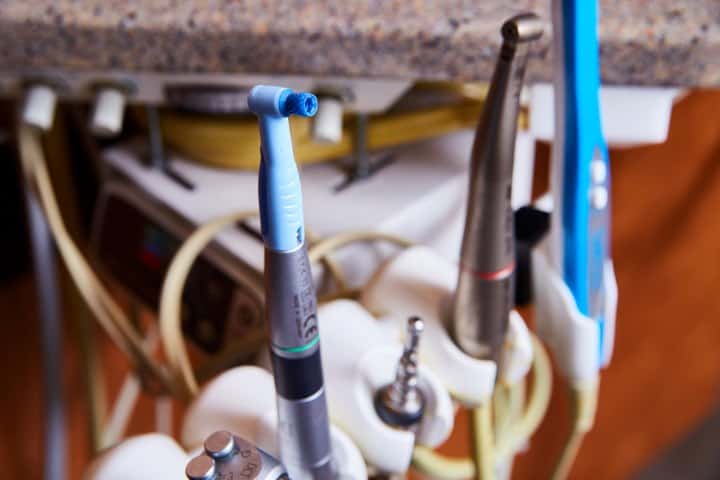Splinters in the mouth or bone spurs or bone spicules are the very tiny parts of your bone or teeth that cause a lot of pain in your mouth upon any pressure or mastication.

This particularly happens after a dental treatment, especially a tooth extraction.
What are Dental Bone Spurs?
After a tooth extraction of your wisdom tooth or a full mouth extraction for your dentures, you may have a bone spur.
These are the tiny structures that develop on the top of your existing bone. The tiny fragments of bone that are in your gums may cause you discomfort.
It is not something that your dentist did something wrong, it is something that sometimes happens due to the fragility of your bone.
Your body has a natural tendency to get rid of the extras. In the defense, your body is trying to get rid of them. The body tries to push them out of the bone. In an attempt, these sometimes resorb on their own, while sometimes they come onto the surface, causing pain.
What causes dental bone spurs?
There are a lot of things that cause bone spurs to develop other than dental extractions. These include:
- Traumatic injury
- Tooth decay
- Dental infection
- Gum infection
- Age
- Joint disorders
Symptoms of bone spurs in the mouth
Apart from a basic symptom of pain, you may experience some other symptoms too. Other symptoms include:
1) discomfort and agitation.
2) pain enhancement upon pressure application.
3) swollen or bleeding gums

4) infection – redness, fever, malaise
5) roughness of your gums
6) bony fragment to be seen with the naked eyes in your gums
How are dental bone spurs diagnosed?
Don’t worry, your dentist will better be able to diagnose it once you visit him.
The diagnosis is simply made by running the finger on the bony fragment. If that feels painful, it means you’re having a bone spur.
The dentist might require your dental history, like the history of previous extractions and infections.
Your dental practitioner might get an X-ray done to be confident about the diagnosis.
What are some of the treatment options available to get rid of the bone spurs?
It is easy to misdiagnose bone spur. A few times, a fragment of the tooth or some other oral tissue dislodged during the treatment may be considered a bone fragment.
However, a thorough diagnosis is necessary.
Your dentist will choose to remove the bony spicule carefully under local anesthesia.
Early, prompt removal will keep you safe from oral infection or will also keep you safe from discomfort when you wear dentures after a full-mouth extraction.
How will the dentist remove a bone spur?
Your dentist or oral surgeon will follow the following steps to remove the piece of bone from your mouth:

- Application of local anesthesia at the affected site.
- Will raise a flap to expose the area.
- Will use a bone filer to filer the bone and smoothen it out. He might use a bone rounder to cut the heavier bony spicule.
- Next, he’ll stick back the flap to its original position with the sutures.
This process is called alveoloplasty. Alveolo means bone, and plasty means molding.
Can you treat bone spurs at home?
Over time, once your bone heals, the bony spicules will find their way and come to the surface.
Usually, the bony part resorbs over some time, but you might need professional help if it turns out to be painful.
You may feel pain post-tooth extraction which you may confuse with the pain associated with bone spurs.
However, you may give yourself a healing time for at least 7 days. A few things that can help you overcome the painful feelings are:
1) over-the-counter painkillers
2) pain relieving oral gel
3) warm saltwater rinses.
4) An adequate oral hygiene maintenance
5) No use of cigarettes and alcohol products.
How to prevent bone spurs in the mouth?
Bone Spurs can occur due to a lot of causes. You can prevent them by following simple instructions.
1) Practice proper oral hygiene. Brush and floss regularly. This will keep your teeth, gums, and bone healthy and will keep you safe from having age-related and trauma-related bone spurs.
2) Get yourself checked with your dentist regularly. Early identification of bone spurs can protect you from intense pain and discomfort.
3) Quit smoking. Smoking contributes to the development of bone spurs as it reduces the blood supply to your gums and bones.
Are bone spurs and dental exostoses the same?
No. Bony spurs and bony protrusions or exostoses are two different things. A bone growth on an existing bone may be painless sometimes, and it doesn’t cause any pain or complications.
Such dental exostoses are usually found on the palate or the floor of your mouth alongside your jawbone.
Maintaining good oral hygiene, brushing and flossing daily, and seeing a dentist regularly may cause no problems with dental exostoses.
Sometimes, dental exostoses may cause difficulty in your daily tasks like speaking or wearing a denture. Your dentist or oral surgeon might advise its removal in that case.
Can bone spurs happen in any part of the body?

Yes. Bone spurs are bony fragments that form in any part of the body.
They aren’t problematic most of the time, but they may cause pain upon application of pressure. Some areas where bone spurs can form other than the oral cavity are:
1) Hands
2) Feet’s
3) Hips
4) Shoulders
5) Knees
6) Neck
7) Spine








